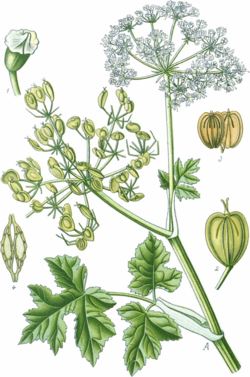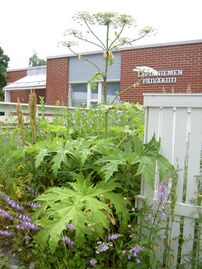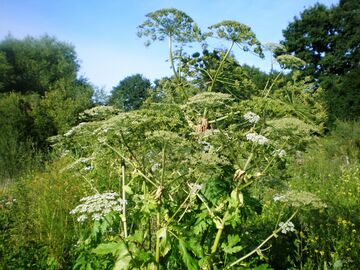Biology:Heracleum (plant)
| Heracleum | |
|---|---|

| |
| Heracleum sphondylium | |
| Scientific classification | |
| Kingdom: | Plantae |
| Clade: | Tracheophytes |
| Clade: | Angiosperms |
| Clade: | Eudicots |
| Clade: | Asterids |
| Order: | Apiales |
| Family: | Apiaceae |
| Subfamily: | Apioideae |
| Tribe: | Tordylieae |
| Subtribe: | Tordyliinae |
| Genus: | Heracleum L. |
| Synonyms[1] | |
| |
Heracleum is a genus of biennial and perennial herbs in the carrot family Apiaceae. They are found throughout the temperate northern hemisphere and in high mountains as far south as Ethiopia. Common names for the genus or its species include hogweed[2] and cow parsnip.[3][4]
The genus name Heracleum was described by Carl Linnaeus in 1753.[4] It derives from the Ancient Greek Ἡράκλειος (Hērákleios) "of Heracles", referring to the mythological hero.
Species
Many species of the genus Heracleum are similar in appearance.[5] An outlier is H. mantegazzianum, the large size of which is exceptional. Common species include:
- Heracleum mantegazzianum, giant hogweed, native to the western Caucasus region of Eurasia, a serious invasive species in many areas of Europe and North America
- Heracleum sosnowskyi, Sosnowsky's hogweed, native to the eastern Caucasus, a common weed throughout Europe and Asia
- Heracleum persicum, Persian hogweed, native to Iran, Iraq, and Turkey
- Heracleum sphondylium, common hogweed, native to Europe and Asia
- Heracleum maximum, cow parsnip, native and common in North America
(As of January 2022), Plants of the World Online accepts the following 88 species:,[1] it had previously in 2019, up to 148.
Giant hogweed, Heracleum mantegazzianum
Sosnowsky's hogweed, Heracleum sosnowskyi
Cow parsnip, Heracleum maximum
Common hogweed, Heracleum sphondylium
Classification and naming
Other than size, the related species H. mantegazzianum, H. sosnowskyi, and H. persicum have very similar characteristics. The common name giant hogweed usually refers to H. mantegazzianum alone but in some locales that common name refers to all three species as a group.[6][5] Both H. maximum and H. sphondylium are often referred to as cow parsnip. To avoid confusion, these species are sometimes referred to as American cow parsnip and European cow parsnip, respectively.[7][8]
The morphological similarity of species within the genus Heracleum and the difficulty of botanical identification has led to numerous synonyms and naming issues. For example, the classification of the species now widely known as H. maximum has been inconsistent. In the literature, the scientific names H. lanatum, H. maximum, and others are used interchangeably. Prior to 2000, the former name was most popular, but today the latter name is in vogue.
Phototoxic effects
Most species of the genus Heracleum are known to cause phytophotodermatitis.[9] In particular, the public health risks of giant hogweed (H. mantegazzianum) are well known.[10][11][12]
At least 36 species of the genus Heracleum have been reported to contain furanocoumarin,[13] a chemical compound that sensitizes human skin to sunlight.[citation needed] Of those, at least 25 species contained a psoralen derivative, either bergapten (5-methoxypsoralen) or methoxsalen (8-methoxypsoralen). Three of those species (H. mantegazzianum, H. sosnowskyi, and H. sphondylium) were found to contain both psoralen derivatives.
References
- ↑ 1.0 1.1 "Heracleum L. | Plants of the World Online | Kew Science" (in en). https://powo.science.kew.org/taxon/urn:lsid:ipni.org:names:30054087-2.
- ↑ hogweed[|permanent dead link|dead link}}] at Oxford Online Dictionaries
- ↑ Bailey, L.H.; Bailey, E.Z.; the staff of the Liberty Hyde Bailey Hortorium (1976). Hortus third: A concise dictionary of plants cultivated in the United States and Canada. New York: Macmillan. ISBN 978-0-02-505470-7. https://archive.org/details/hortusthirdconci00bail.
- ↑ 4.0 4.1 "Heracleum L.". Tropicos.org. Missouri Botanical Garden. http://www.tropicos.org/Name/40024239.
- ↑ 5.0 5.1 MacDonald, Francine; Anderson, Hayley (May 2012). "Giant Hogweed (Heracleum mantegazzianum): Best Management Practices in Ontario". Ontario Invasive Plant Council, Peterborough, ON. https://www.ontarioinvasiveplants.ca/wp-content/uploads/2016/06/OIPC_BMP_Hogweed.pdf.
- ↑ Booy, Olaf; Cock, Matthew; Eckstein, Lutz; Hansen, Steen Ole; Hattendorf, Jan; Hüls, Jörg; Jahodová, Sárka; Krinke, Lucás et al. (2005). The giant hogweed best practice manual: guidelines for the management and control of invasive weeds in Europe. Hørsholm: Center for Skov, Landskab og Planlægning/Københavns Universitet. ISBN 87-7903-209-5. https://static-curis.ku.dk/portal/files/20497522/kaempe_bjorneklo_eng.pdf. Retrieved September 1, 2018.
- ↑ "Heracleum sphondylium common names". http://eol.org/pages/581673/names/common_names.
- ↑ "German-English Dictionary: cow parsnip". https://www.dict.cc/english-german/cow+parsnip.html.
- ↑ McGovern, Thomas W; Barkley, Theodore M (1998). "Botanical Dermatology". The Electronic Textbook of Dermatology (Internet Dermatology Society) 37 (5): Section Phytophotodermatitis. doi:10.1046/j.1365-4362.1998.00385.x. PMID 9620476. http://telemedicine.org/botanica/bot1.htm. Retrieved August 11, 2018.
- ↑ Gander, Kashmira (June 18, 2018). "Giant Hogweed Warning: Plant That Can Cause Blindness, Burn Skin, Spreads Into New State". Newsweek. https://www.newsweek.com/giant-hogweed-warning-spreads-new-state-980684.
- ↑ Patocka, Jiri; Cupalova, Klara (2017). "Giant Hogweed And Photodermatitis". Military Medical Science Letters 86 (3): 135–138. doi:10.31482/mmsl.2017.021. ISSN 0372-7025. https://www.mmsl.cz/pdfs/mms/2017/03/06.pdf.
- ↑ Camm, E; Buck, HW; Mitchell, JC (1976). "Phytophotodermatitis from Heracleum mantegazzianum". Contact Dermatitis 2 (2): 68–72. doi:10.1111/j.1600-0536.1976.tb02987.x. PMID 1017181.
- ↑ Mitchell, John; Rook, Arthur (1979). Botanical Dermatology: Plants and Plant Products Injurious to the Skin. Vancouver: Greengrass. pp. 692–699.
Bibliography
- Logacheva, Maria; Valiejo-Roman, C. M.; Pimenov, Michael (February 2007). "ITS phylogeny of West Asian Heracleum species and related taxa of Umbelliferae–Tordylieae W.D.J.Koch, with notes on evolution of their psbA-trnH sequences". Plant Systematics and Evolution 270 (3): 139–157. doi:10.1007/s00606-007-0619-x.
Wikidata ☰ Q327106 entry
 |






